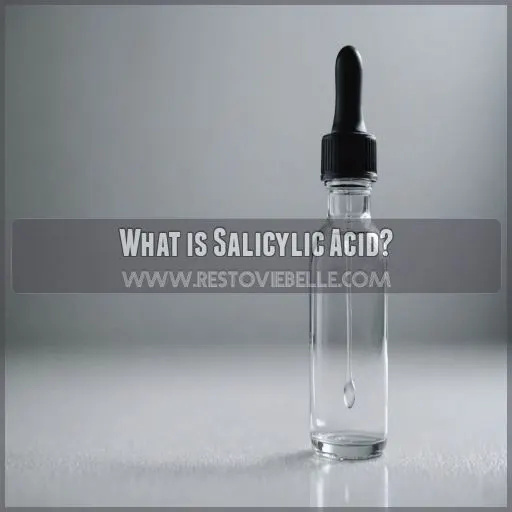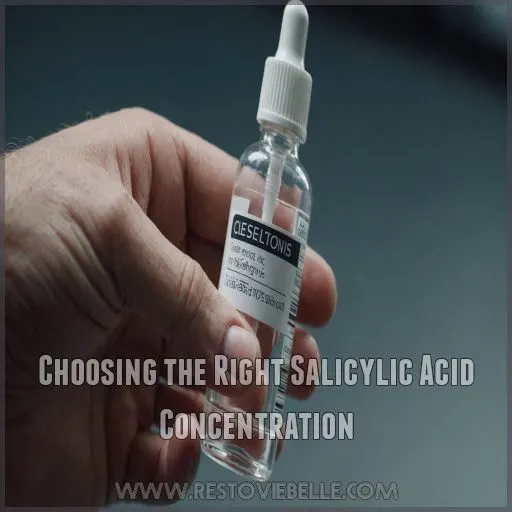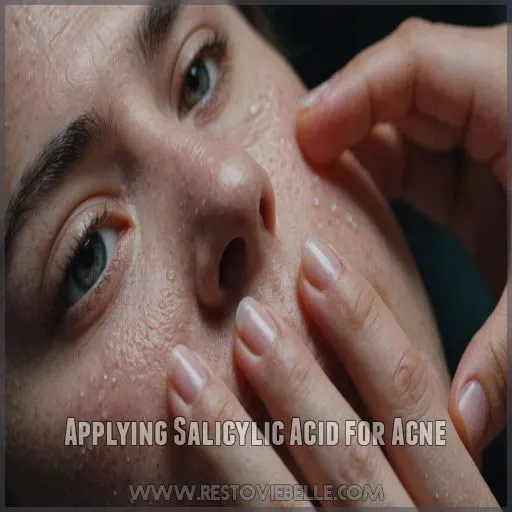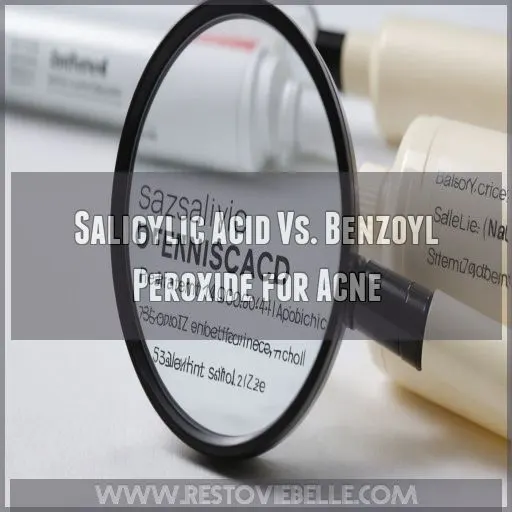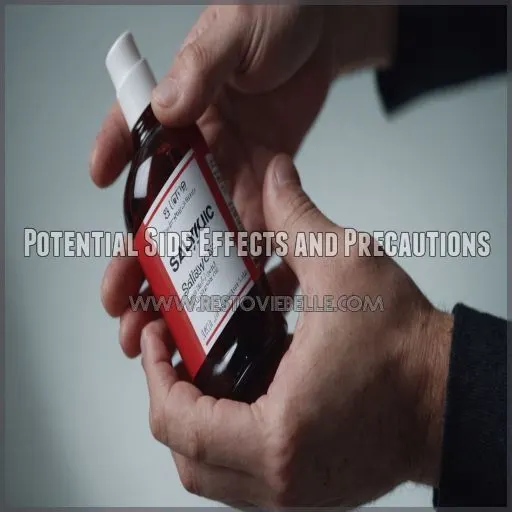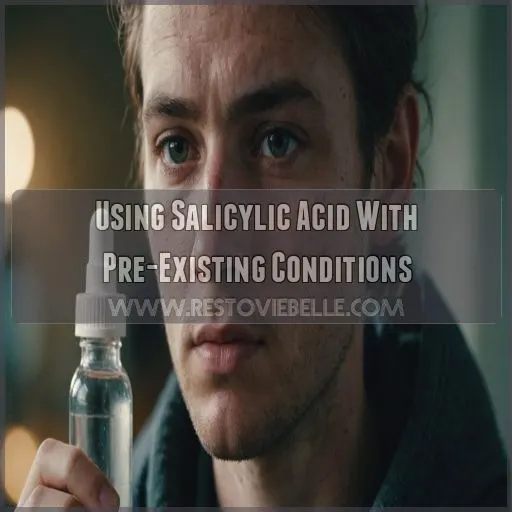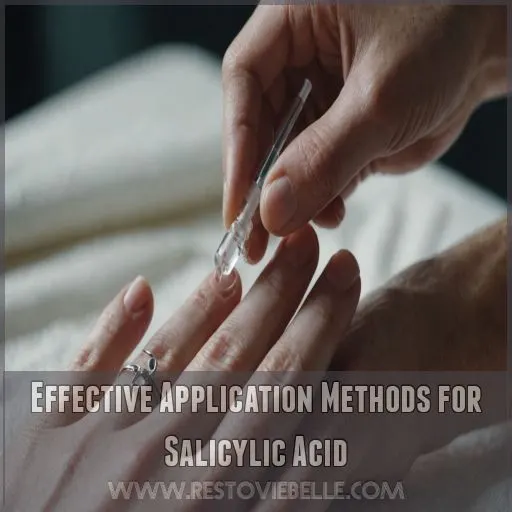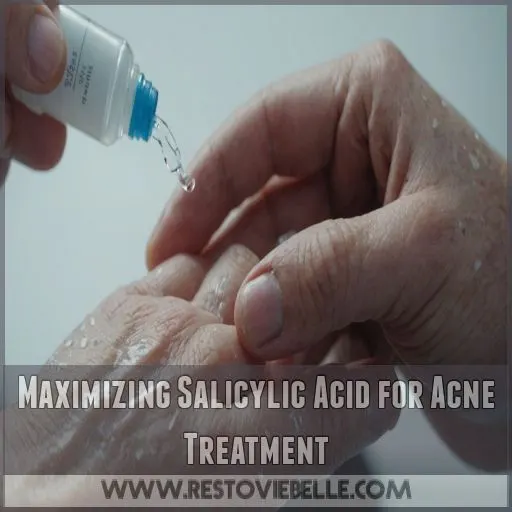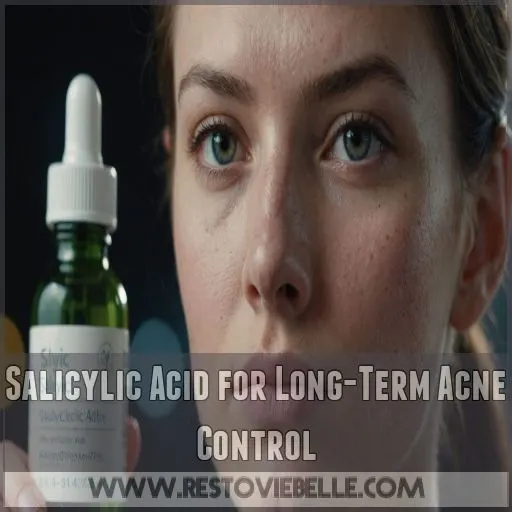This site is supported by our readers. We may earn a commission, at no cost to you, if you purchase through links.
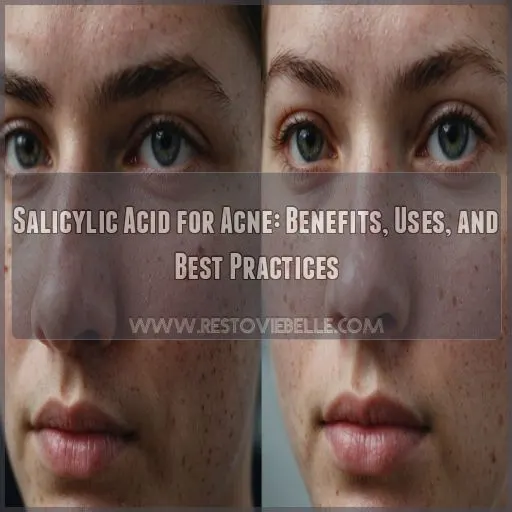 To beat acne with salicylic acid, wash your face with a mild cleanser and dry it gently.
To beat acne with salicylic acid, wash your face with a mild cleanser and dry it gently.
Apply a thin layer of salicylic acid to the acne-prone areas once or twice a day.
Start low if you’re a newbie (0.5% is perfect) and work up if your skin’s cool with it.
Keep it out of your eyes and do a patch test because surprises aren’t always fun!
If things get too hot to handle (irritation), pause and chat with a dermatologist.
Ready to learn more about salicylic acid? Stick around for more skin-smart moves!
Table Of Contents
- Key Takeaways
- What is Salicylic Acid?
- How Does Salicylic Acid Work for Acne?
- Choosing the Right Salicylic Acid Concentration
- Applying Salicylic Acid for Acne
- Salicylic Acid Vs. Benzoyl Peroxide for Acne
- Potential Side Effects and Precautions
- Using Salicylic Acid With Pre-Existing Conditions
- Effective Application Methods for Salicylic Acid
- Maximizing Salicylic Acid for Acne Treatment
- Salicylic Acid for Long-Term Acne Control
- Frequently Asked Questions (FAQs)
- How do you apply salicylic acid to a pimple?
- How often should I use salicylic acid for acne?
- Do you wash off salicylic acid or leave it on?
- Does salicylic acid clear acne fast?
- Can salicylic acid cause skin dryness?
- Is salicylic acid safe for all skin types?
- How long does it take for salicylic acid to work?
- Can salicylic acid treat acne scars?
- Can salicylic acid make acne worse?
- Conclusion
Key Takeaways
- Start low and go slow with salicylic acid, especially if you’re new to using it. Begin with a 0.5% concentration, then work your way up as your skin becomes more comfortable. Think of it as teaching a puppy new tricks—patience is crucial!
- Always do a patch test before diving into regular use. It’s like taste-testing at a new restaurant; better safe than dealing with a culinary—or in this case, skin—disaster.
- Don’t mix too many acne treatments at once. Combining salicylic acid with benzoyl peroxide can be powerful, but moderation is key. You don’t want your skin throwing a wild party without a chaperone!
- Moisturize, moisturize, moisturize! Salicylic acid can dry you out faster than a sunbather without sunscreen. Slather on hydration to keep your skin happy and flake-free.
What is Salicylic Acid?
Salicylic acid is a natural wonder that can work wonders for your skin.
This beta hydroxy acid is a powerful exfoliant and antibacterial agent that can help unclog pores, reduce inflammation, and prevent future breakouts.
Natural Source and Anti-Inflammatory Properties
With salicylic acid, think of it as nature’s gift from willow bark with anti-inflammatory benefits.
This beta hydroxy acid works wonders for skin health, especially in acne treatment.
Just like a wise old gardener pruning away dead leaves, salicylic acid helps keep clogged pores in check.
It’s like having a pit crew for your skin, tackling oil and maintaining smoothness.
Exfoliating and Antibacterial Effects
Salicylic acid works wonders for your skin, particularly in combating acne. It’s like a superhero in the battle against pore-clogging culprits.
By exfoliating, SA for blackheads breaks down those pesky barriers. The antibacterial benefits help fend off acne-causing germs.
Imagine waving goodbye to oily skin, as salicylic acid benefits keep things balanced. So, let SA join your squad for clearer, brighter skin!
Common Concentrations in Skincare Products
You’re diving into skincare, where salicylic acid percentages range from 0.5% to 2% in over-the-counter options.
Perfect for acne-prone skin types, these products are like trusty sidekicks for tackling stubborn pimples.
Forget DIY salicylic acid—stick to reliable store-bought solutions.
How Does Salicylic Acid Work for Acne?
Salicylic acid is a skincare powerhouse for tackling acne.
By breaking down dead skin cells and excess oil, it unclogs pores and reduces inflammation.
This helps to prevent future breakouts and keep your complexion clear.
Breaking Down Dead Skin Cells and Oil
Understanding the magic behind salicylic acid for blackheads means realizing its role in breaking down stubborn dead skin cells and oils.
Imagine SA as your skin’s personal janitor, ensuring smooth skin cell turnover and oil control without causing skin irritation.
Incorporate it into your exfoliating routine with face wash, battling acne and diminishing acne scars like a pro. You’ll see your skin singing, trust me.
Unclogging Pores and Reducing Inflammation
Imagine your pores as little doorways that need occasional decluttering. Salicylic acid steps in like a tidy housekeeper, effectively unclogging those doorways and calming inflammation.
This ingredient dives deep into your skin, tackling acne by breaking down oils and dead cells.
With consistent use, salicylic acid becomes your go-to treatment for smoother, healthier skin. It’s like a spa day, but every day!
Preventing Future Breakouts
When you’re on a mission against cystic or hormonal acne, salicylic acid is your wingman, keeping future breakouts at bay! It sneaks into pores like a superhero, clearing out oil and dead skin.
For long-term success, pair it with a steady skincare routine, balanced diet, stress management, and good sleep.
Don’t forget sun protection, like Neutrogena Oil-Free Acne Wash. Teamwork makes the dream work!
Choosing the Right Salicylic Acid Concentration
If you’re using salicylic acid for acne, the concentration really matters.
Over-the-counter treatments typically range from 0.5% to 2%, while professional-strength chemical peels can go up to 50% – so be sure to follow the product instructions carefully, especially if you have sensitive skin.
Over-the-Counter Topical Treatments (0.5-2%)
Looking to take control of your acne with a trusty companion? Over-the-counter topical treatments featuring salicylic acid, ranging from 0.5% to 2%, are your new skincare MVPs.
Brands like CeraVe SA can zap zits without emptying your wallet. Just follow the instructions, and don’t forget: patience is key.
While exfoliating with SA, avoid the AHA vs. SA debate—each has its spotlight!
Chemical Peels (Up to 50% Concentration)
Considering a salicylic acid chemical peel? These peels can pack a punch, using concentrations up to 50%.
But they’re a bit like handling fireworks—you’ll want a professional to make sure safety and effectiveness.
Peels can lighten hyperpigmentation and zap stubborn acne, but tread carefully: risks include irritation and over-sensitivity.
Aftercare is essential as your skin might feel like it went on a wild rollercoaster ride!
Concentration for Sensitive Skin
If sensitive skin‘s your companion, a gentle touch with salicylic acid is best. Start with a low concentration, say 0.5%, to keep irritation risk at bay.
As the American Academy of Dermatology suggests, a patch test can prevent surprises.
Nail this start, and you’ll become the maestro of SA products. Remember, skin care tips aren’t just instructions; they’re your roadmap to control.
Applying Salicylic Acid for Acne
It’s really important to follow the product instructions for salicylic acid for acne.
Don’t be afraid to patch test first – your skin will thank you for taking the extra precaution to avoid any unwanted irritation around the eyes or other sensitive areas.
Following Product Instructions and Guidelines
You’re one step closer to flawless skin! To make the most of salicylic acid, remember these golden rules:
- Read the label: Follow product instructions and guidelines from the get-go.
- Less is more: Resist overuse; too much can lead to irritation, and we don’t want that.
- Adapt to your skin type: Check what works best for you.
- Consult authority: Trust experts like the American Academy of Dermatology.
Patch Testing for Sensitivity
Before jumping in with both feet, it’s wise to patch test salicylic acid products to keep allergy risks in check.
Apply a tiny amount to a discreet spot, like your arm, and wait 24 hours.
This checks for sensitivity or irritant contact dermatitis.
Knowing your skin type is key—ain’t nobody got time for nasty side effects or toxic surprises!
Stay ahead by reading product ingredients.
Avoiding Contact With Eyes and Mucous Membranes
Applying salicylic acid calls for some finesse—no one wants a "chemical peel in the eye" moment! To dodge eye irritation and keep mucous membranes happy, adhere to product application tips. Use only as directed, and focus on targeted skin areas. Accidentally smear some in your eye? Rinse with lukewarm water pronto. The American Academy of Dermatology and the FDA recommend these salicylic acid toxicity precautions.
Salicylic Acid Vs. Benzoyl Peroxide for Acne
If you’re trying to clear up acne, you may wonder whether to use salicylic acid or benzoyl peroxide.
Both are effective, but they work in different ways – benzoyl peroxide kills acne-causing bacteria, while salicylic acid unclogs pores.
Combining the two can provide a powerful one-two punch against stubborn breakouts.
Killing Acne-Causing Bacteria With Benzoyl Peroxide
Incorporating salicylic acid into your routine is like giving your skin a friendly nudge to clarity.
Now, onto benzoyl peroxide—this powerhouse ingredient tackles acne-causing bacteria head-on.
Here’s why it’s worth a try:
- Kills Bacteria: Effective against acne-causing culprits.
- BP for Sensitive Skin: Start with lower concentrations.
- BP Usage Frequency: Follow label directions; don’t overdo it.
Combined Use of Salicylic Acid and Benzoyl Peroxide
Combining salicylic acid and benzoyl peroxide for acne is like a dynamic duo tackling crime in your pores! Here’s how they stack up:
| Benefits | Side Effects | Frequency |
|---|---|---|
| Clears acne | Possible irritation | Daily use |
| Unclogs pores | Dryness | Morning/night |
| Exfoliates skin | Stinging | As needed |
| Prevents future | Peeling | Varies |
| Reduces oil | Sensitivity | Consistent |
Use the best products at recommended dosages. Don’t mix too much or too often—moderation’s the name of the game!
Sensitivity and Concentration of Benzoyl Peroxide
Feeling like a scientist in a skincare lab? Balancing salicylic acid with benzoyl peroxide can be like a chemistry experiment.
Sensitivity to benzoyl peroxide isn’t uncommon.
For starters:
- Begin with 2.5% concentration levels: Higher doses might ruffle your skin’s feathers.
- Observe side effects carefully: Like irritation or redness.
- Check compatibility: Not everyone’s skin dances well with benzoyl peroxide.
Choose wisely for your ultimate acne treatment adventure!
Potential Side Effects and Precautions
Using salicylic acid can sometimes cause mild stinging, dryness, or peeling – but don’t worry, these side effects are usually manageable.
If you experience excessive irritation, stop using the product and consult your dermatologist to find the right salicylic acid regimen for your skin.
Mild Burning, Stinging, and Irritation
Dealing with some mild burning, stinging, or irritation after using salicylic acid is like feeling a pinch to get the prize.
But don’t fret! If your skin sensitivity feels off the charts, try patch testing first. This helps you dodge irritant contact dermatitis before it spoils the party.
For reducing redness, consider switching to gentle alternatives like glycolic acid. Stay fabulous without the fuss!
Dryness and Peeling
You’re using salicylic acid to combat acne, but suddenly your face feels like the Sahara Desert—dryness and peeling can sneak up faster than a cat on catnip! Fear not, a good moisturizer is your solution. Prevent dryness and peeling by applying hydrating lotions daily.
And hey, when dryness hits, don’t just grit your teeth—embrace the power of moisturizers to keep your skin happy.
Discontinuing Use and Consulting a Doctor
If your skin throws a fit and those pesky side effects rear their ugly heads, like singing red flags, it’s time to rethink.
Here’s your game plan:
- Stop using the product right away.
- Visit your doctor, particularly if you have liver or kidney disease concerns.
- Discuss salicylic toxicity or treatment changes.
Using Salicylic Acid With Pre-Existing Conditions
If you have pre-existing skin conditions like allergies, eczema, or sensitive skin, you’ll need to approach using salicylic acid with extra care.
Consult your dermatologist to make sure it’s safe for your unique skin type and to get personalized guidance on how to incorporate it into your routine.
Allergies and Skin Sensitivities
| Trigger | Reaction |
|---|---|
| Fragrance | Redness, Itching |
| Alcohol | Dryness, Peeling |
| Chemical Exfoliants | Stinging, Irritation |
| Dyes | Rash, Discoloration |
Always check product ingredients in your skincare routine and seek safe alternatives if needed.
Pregnancy and Breastfeeding
Pregnancy and breastfeeding can be a bumpy road, so when considering salicylic acid, it pays to be cautious. Here’s a quick rundown:
- Topical Safety: Generally safe in small amounts, but always consult your OB-GYN.
- Breastfeeding Concerns: Limited absorption into the bloodstream means minor risk, but better safe than sorry.
- Alternative Treatments: Consider gentler options like oatmeal masks.
- Expert Advice: Always prioritize professional guidance.
Eczema and Sensitive Skin
Got eczema or super sensitive skin? Using salicylic acid can be like dancing on a tightrope. It’s effective but might agitate your eczema.
Focus on gentle cleansing and watch for eczema triggers.
Manage flare-ups cautiously; start with lower concentrations and patch test. It’s like testing waters before diving in.
Effective Application Methods for Salicylic Acid
Applying salicylic acid correctly is key to getting the most out of this acne-fighting ingredient.
Whether you’re spot-treating a pesky pimple or incorporating it into your daily routine, following the right application methods can make all the difference in clearing up your complexion.
How to Apply Salicylic Acid to a Pimple
So, you’ve got a pimple you want to zap, huh? Here’s how to apply salicylic acid effectively:
- Clean your face – No grime or oil to hinder your treatment.
- Target application – Dab a small amount on the spot.
- Leave it on – For overnight magic, unless the product suggests washing off.
- Stay consistent – But not overly enthusiastic to avoid irritation.
Feeling like a pimple-busting superhero yet?
Frequency of Use for Acne
Wondering how often to apply salicylic acid without bursting your skin’s bubble? Typically, using it daily or every other day strikes the right balance.
Overuse can dry out your skin, so don’t get too enthusiastic. Try applying it in the evening when the skin’s less exposed to sun.
Weekly check your skin’s response—like a gardener tending to plants—to avoid doing too much.
Washing Off or Leaving on Salicylic Acid
In exploring frequency, you’d naturally ponder whether salicylic acid is a wash-off or leave-on player in acne care. Here’s the scoop:
- Wash-Off Products: Gently cleanse, then rinse off.
- Leave-On Treatments: Apply and let them work overnight, like tiny but mighty skincare elves.
- Consider Skin Type: Oily types love leave-ons.
- Application Tips: Follow product instructions for best results.
Maximizing Salicylic Acid for Acne Treatment
To get the most out of salicylic acid for your acne, consider combining it with other proven treatments and using it as part of a regular exfoliating routine.
Exfoliating routine and usage adjustments can help maximize the benefits of this powerful acne-fighting ingredient.
Combining With Other Acne Treatments
Applying salicylic acid effectively can feel like finding treasure hidden beneath a skincare routine.
You might ask how this pairs with retinol or benzoyl peroxide?
The secret sauce lies in balancing it with topical treatments or oral medications.
Sprinkle in some lifestyle changes like healthy eating or good bedtime rituals, and you’re ready for clearer, more radiant skin!
Ain’t that something to smile about?
Exfoliating With Salicylic Acid
So, you’ve tried various treatments, but let’s chat about salicylic acid types for exfoliation.
It’s like giving your skin a clean slate.
Use it wisely for sensitive skin; too much love can lead to irritation.
Consider body exfoliation too, but start with low-frequency DIY masks.
Monitoring Progress and Adjusting Use
As you exfoliate with salicylic acid, keep a keen eye on how your skin changes. If it seems like your breakouts persist or your skin feels a tad dramatic, don’t fret! It’s a trial and error process. Adjust frequency or try a different product. Remember, skincare is like dating—you might need to kiss a few frogs.
- Notice improvement?
- Feeling more confident?
- Resolved stubborn spots?
- Smoother texture?
- Happier skin glow?
Salicylic Acid for Long-Term Acne Control
Salicylic acid can be your long-term ally in the fight against acne. By incorporating it into your regular skincare routine, you can maintain clearer, healthier skin and prevent future breakouts.
Maintaining Healthy Skin With Salicylic Acid
Continuing a skincare routine with salicylic acid can help you keep acne at bay and maintain your skin’s glow.
It’s a fantastic ally for long-term results and acne prevention.
Think of salicylic acid as your secret weapon in your daily battle against breakouts.
| Step | Tip |
|---|---|
| Cleanse | Use a gentle face wash. |
| Tone | Opt for an acid-based toner. |
| Moisturize | Lock in hydration without oil. |
| Protect | Never skip the sunscreen, rain or shine. |
Tame those pesky pimples without breaking a sweat!
Regular Use and Monitoring
Using salicylic acid, consistency is key. You’re not just aiming for immediate results but long-term effects. Keep an eye on skin changes and track your progress.
That way, you’ll know if it’s working or if it’s time to tweak your routine. Remember, even if you’re feeling discouraged, those pesky pimples are no match for a good plan. Just be aware of any side effects, and don’t hesitate to consult with a dermatologist if needed.
With a little patience and persistence, clear skin isn’t just a dream—it’s your new reality!
Frequently Asked Questions (FAQs)
How do you apply salicylic acid to a pimple?
To zap that pesky pimple, dab a tiny bit of salicylic acid directly on the spot.
This exfoliating superhero loosens dead skin cells and oil, unclogging pores.
Just mind the dose—no need to go bananas!
How often should I use salicylic acid for acne?
Similarly to seasoning a salad, sprinkle salicylic acid onto your skin sparingly.
Start using it two to three times a week, then ramp it up as needed.
Listen to your skin, and adjust accordingly for the best results.
Do you wash off salicylic acid or leave it on?
Whether to leave salicylic acid on or wash it off depends on the product.
Face washes cleanse quickly, but leave-on treatments penetrate deeper for lasting effects.
Think of it as a coffee break versus a power nap!
Does salicylic acid clear acne fast?
Salicylic acid‘s a skincare ace, a pore-clearing ace up your sleeve.
Though not an overnight fix, it’ll have your complexion looking its best – just don’t rush it, Rome wasn’t built in a day, my friend.
Can salicylic acid cause skin dryness?
Absolutely, salicylic acid can leave your skin feeling as parched as a desert wind if you overdo it.
Balance is key!
Start with lower concentrations and moisturize well to avoid turning your face into a flaky mess.
Is salicylic acid safe for all skin types?
While generally safe, salicylic acid might not be everyone’s cup of tea!
Test it on a small patch first—like dipping a toe in the water—and see how your skin responds before diving in headfirst.
How long does it take for salicylic acid to work?
You’ll typically see improvements in acne after 4 to 6 weeks of using salicylic acid.
Keep calm and carry on with regular use, but don’t expect overnight miracles.
Patience and persistence are your best skincare buddies.
Can salicylic acid treat acne scars?
Ah, the age-old question – can salicylic acid work its magic on those pesky acne scars?
Well, let me tell you, it’s not a miracle cure, but it can certainly help smooth things out.
Just don’t expect overnight results, my friend.
Can salicylic acid make acne worse?
Salicylic acid might cause initial irritation, but it often clears with use.
Breakouts might intensify, but remember, patience is a virtue; this is possibly your skin adjusting.
Just keep it cool and make sure you’re following directions.
Conclusion
Did you know over 85% of people experience acne at some point?
That’s why mastering how to use salicylic acid for acne can be your clear-skin secret weapon.
It unclogs pores, banishes breakouts, and keeps your skin smooth and healthy.
Start with a patch test, choose the right concentration, and be mindful of any reactions.
Keep these tips in mind, and you’ll turn salicylic acid into your skin’s best defense against acne!

